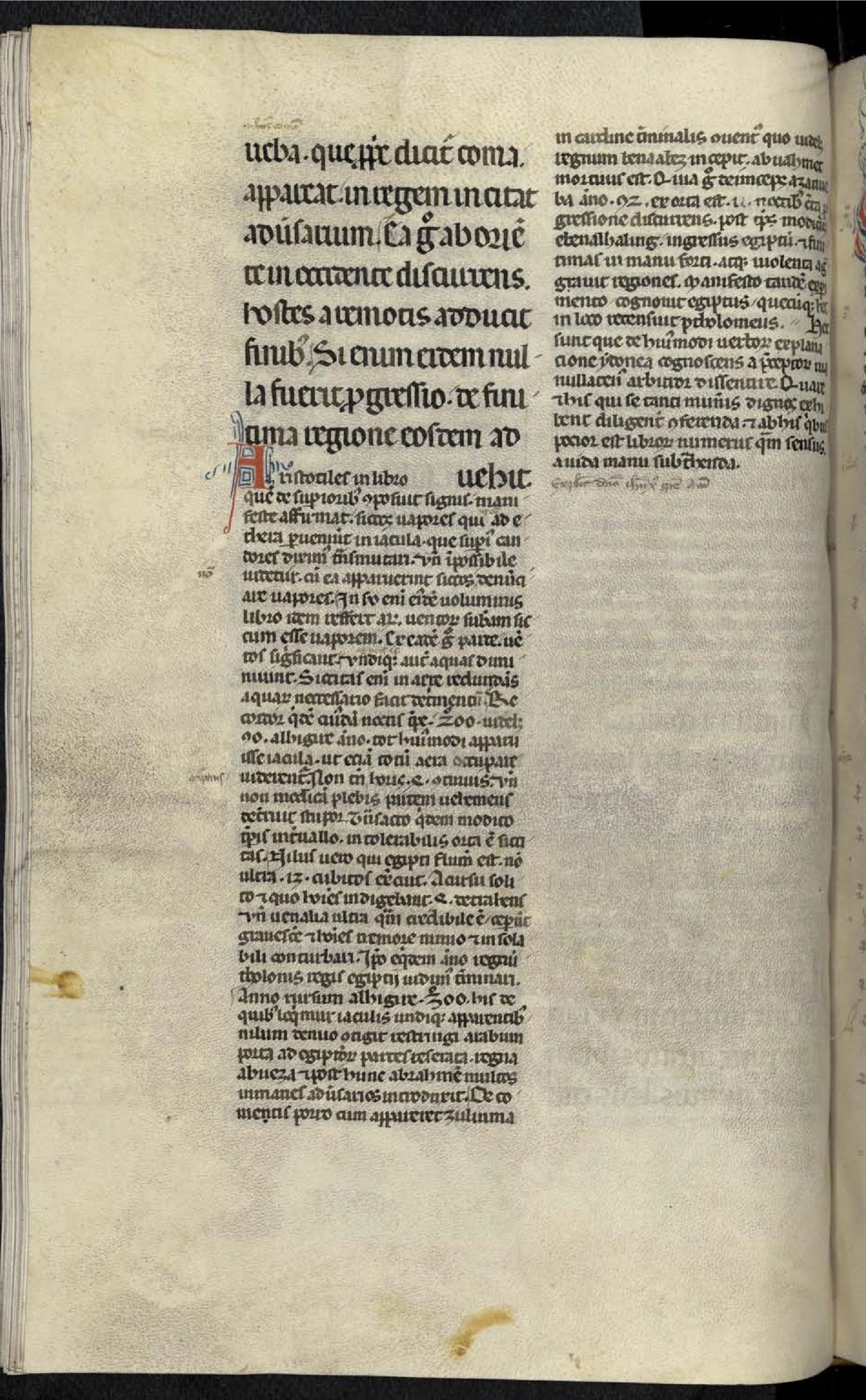ueba Azanueba A] Azanneba B. Cf. in Arabic dhū l-dhawāba (‘bearers of hair’); see Martorello and Bezza, pp. 232-233. que proprie dicitur coma dicitur coma] coma dicitur B. appareat, in regem incitat adversarium. Ea ergo ab occidente in orientem ab occidente in orientem B] ab oriente in occidentem A. discurrens hostes a remotis adducit finibus. Si enim eidem nulla fuerit progressio, de finitima regione eosdem advehit.
Expositio
Aristotiles in libro quem De superioribus composuit This book De superioribus refers to an Arabic version of Aristotle’s Meteorology. The reference is to Meteor, I, 4; see Sezgin, VII, pp. 212-216., signis manifeste affirmat siccos vapores qui ad ethera qui ad ethera] eo quod adhera sic B. perveniunt in iacula que superius candores diximus transmutari, unde impossibile videtur cum ea apparuerint siccos denunciare vapores. In secundo enim eiusdem voluminis libro idem reffert Aristotiles ventorum substanciam siccum esse vaporem. Ex eadem ergo parte ventos significant, undique autem aquas diminuunt. Siccitas enim in aere redundans redundans] reddundans B. aquarum necessario facit detrimentum. Recordor quidem cuiusdam noctis tempore 200 videlicet 90 alhigire 200 videlicet 90 alhigire] CC videlicet XC alhigere B. 290H = from December 5, 902 to November 24, 903CE. anno tot huiusmodi apparuisse iacula ut etiam totum aera occupare viderentur, non tamen amplius amplius B] om. A. horis 4 continuis, unde non modicam plebis partem vehemens deterruit stupor. Transacto quidem modico temporis intervallo intolerabilis intolerabilis] intollerabilis B. orta est siccitas, Nilus vero qui Egipti flumen est non ultra 13 13] XIII B. cubitos exercuit, a cursu solito et quo homines indigebant 4 4] IIII B. detrahens. Unde venalia ultra quam credibile est ceperunt gravescere et homines tremore nimio et insolabili conturbari. Ipso equidem anno regnum Tholonis Tholonis] Ptholonis B., regis regis om. B. Egiptii, vidimus terminari The Tulunid dynasty disappeared in 905CE.. Anno rursum alhigire 300 300] CCC B. The year 300 of the Hegira runs from August 18, 912 to August 7, 913 of the Christian era. Arabic sources indicate the appearance of three stars with tails between May and July 912. In fact, it is probably Halley’s Comet, visible from July 19 to July 28, 912. See D. Cook, ‘A Survey of Muslim Material on Comets and Meteors’, Journal for the History of Astronomy, XXX (1999), p. 139; G. W. Kronk, Cometography. A Catalog of Comets, vol. I, Ancient - 1799, Cambridge, 1999, pp. 146-150. his de quibus loquimur iaculis undique apparentibus Nilum denuo contigit restringi Arabum porta ad Egiptiorum partes reserata regnante regnante B] regna A. Abueza Abueza AB. The Arabic text speaks of Ḥabāsa, a general who was the regent of Egypt after the Tulunids, on behalf of the Fatimid dynasty. See Martorello and Bezza, pp. 234-235 and 348., et post hunc Abrahmen Abrahmen: ʿAbd al-Raḥmān. multos inmanes adversarios introduxit. De cometis porro cum appareret zuliuma zuliuma A; zulinimia B. Cf. supra. in cardine terminalis conventus terminalis conventus AB. According to the previous vocabulary, terminalis corresponds to the Arabic al-intihāʾ and conventus means conjunction. It therefore refers to the profection of the conjunction (small, medium or large) of Saturn and Jupiter that preceded the advent of the Abbasids. quo videlicet regnum Benaabez Benaabez AB, i.e. the Banū ʿAbbās: allusion to the advent of the Abbasids (750). On this ‘comet’ of 137H/754 that was in fact a meteor, see D. Cook, ‘A Survey of Muslim Material’, p. 136. On the conjunction of Saturn and Jupiter of 132H/749 which signified the advent of the Abbasids, see E. S. Kennedy, D. Pingree, The Astrological History of Māshāʾallāh, Cambridge (Mass.,) 1971, pp. 54-56 and 108-111; Abū Maʽšar on Historical Astrology. The Book of Religions and Dynasties (On the Great Conjunctions), ed. and trans. K. Yamamoto, C. Burnett, Leiden-Boston-Cologne, 2000, I, 496-497, 569 and 600-604. incepit, Abu Ahmet Abu Ahmet A] Abuhmet B. This is Abū l-ʿAbbās Aḥmad al-Nāṣir, the first Abbasid caliph (750-754). mortuus est. Quia ergo deinceps azanueba Azanueba AB. Transliteration of the Arab dhawāt al-dhawāʾib. Cf. supra. anno [2]92 92 A; XCII B. 292H = From November 12, 904 to November 2, 905. On this comet, visible from May 18 to June 12, 905, see D. Cook, ‘A Survey of Muslim Material’, p. 139; G. W. Kronk, Cometography, pp. 144-146. exorta est 11 noctibus 11 noctibus] XV noctibus B. certa progressione discurrens, post tempus modicum Ebenalhaling Ebenalhaling A] Enbaenalhaling B. According to Martorello and Bezza, pp. 234-235 and 348, which are based on al-Ṭabarī, it is indeed Ibn al-Khalīg, an Egyptian officer who, in 292H, marched on Egypt in opposition to the central authority. ingressus Egiptum et finitimas in manu forti atque violenta agregavit agregavit] agravavit B. regiones regiones] regionem B.. Manifesto tandem experimento cognovit Egiptus quecumque quecumque] quocumque B. hoc in loco recensuit Ptholomeus.
Hec sunt que de eiusmodi verborum explanatione ydonea cognoscens a preceptorum via nullatenus arbitror dissentire dissentire] discentire B.. Quare et his qui se tanti muneris dignos exhibent diligenter conferenda, et ab his quibus pocior est librorum numerus quam sensus avida manu subtrahenda Explicit domino Ihesu Christo gracias. Amen add. A; Explicit Liber Centiloquiy Ptholomey. Deo gracias rubr. B..
